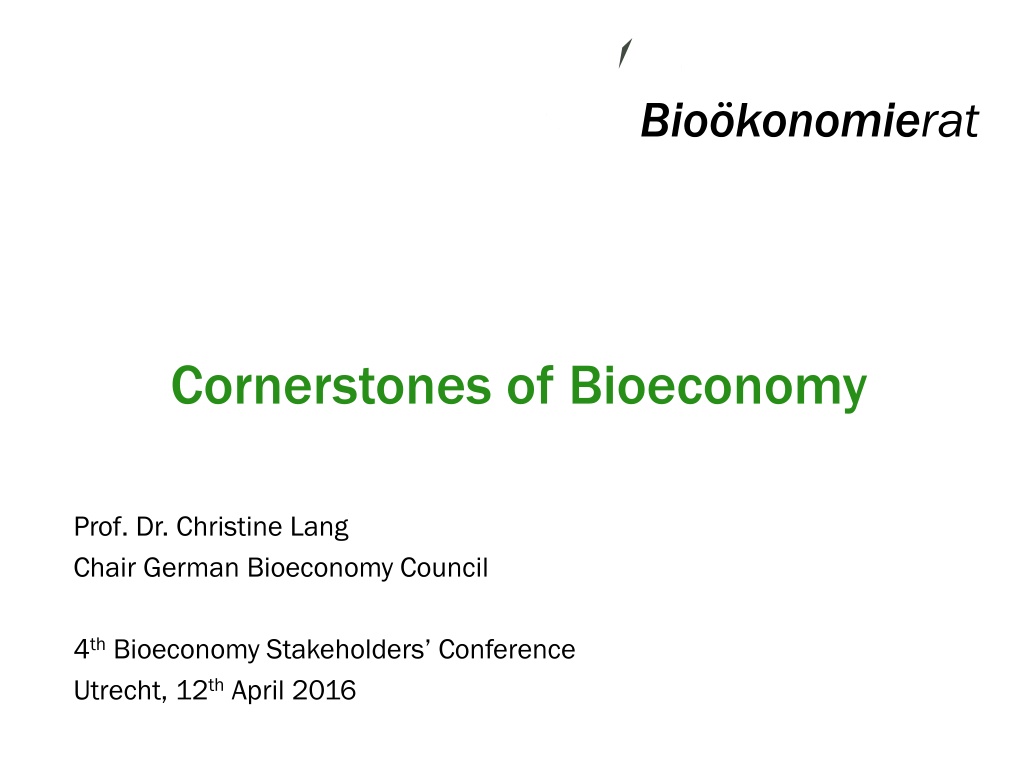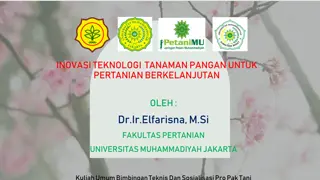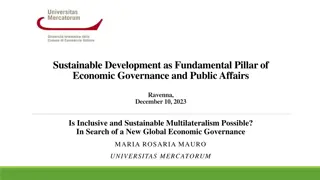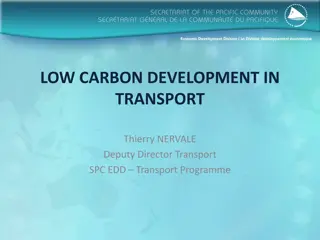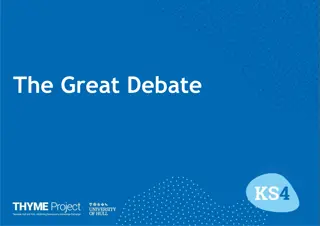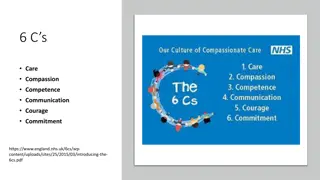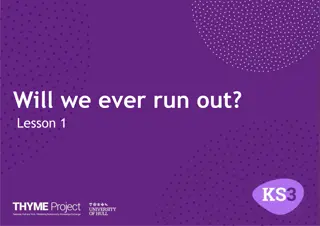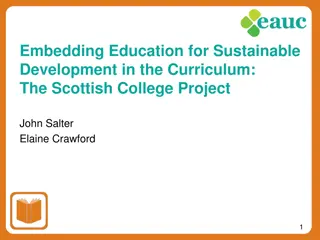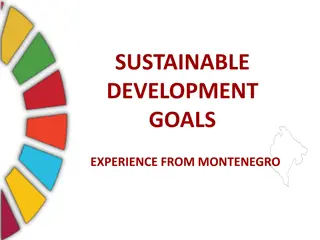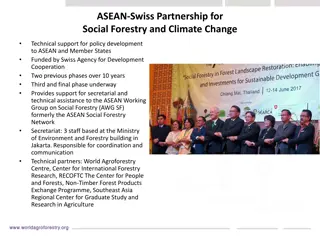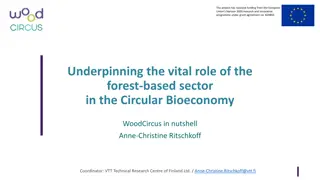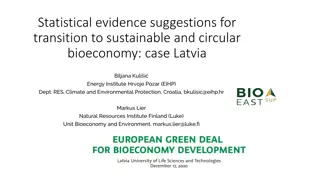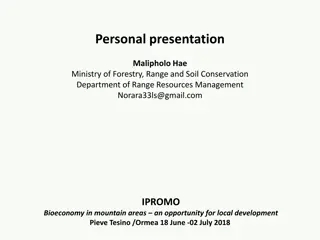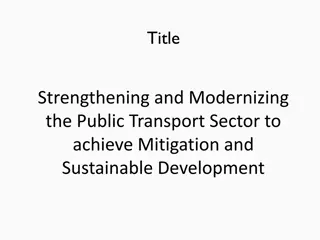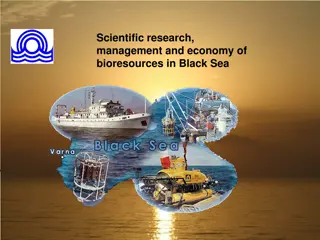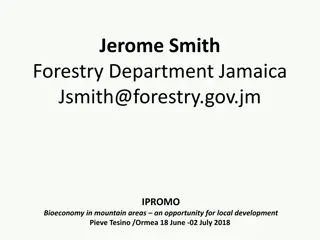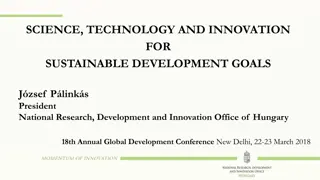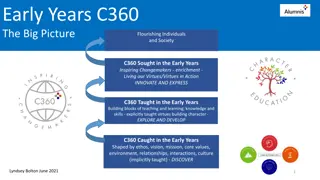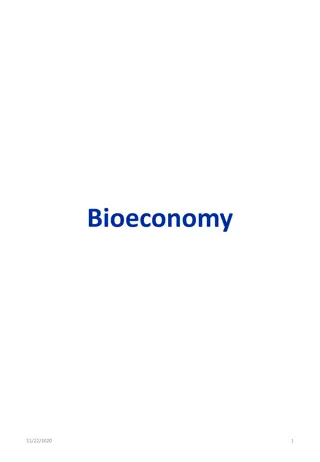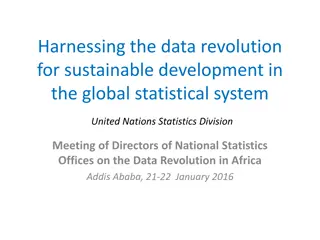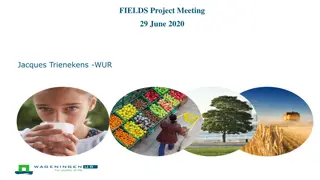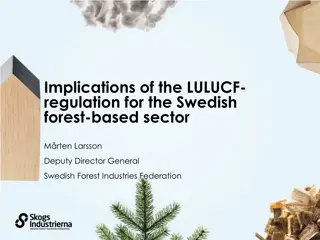Cornerstones of Bioeconomy and Sustainable Development
Bioeconomy encompasses the sustainable production and utilization of biological resources, aiming to reconcile human living with nature. It involves leveraging living organisms, soil, biodiversity, and carbon dioxide to drive green growth, innovation, and societal well-being. The vision is to restore natural capital, promote inclusive societies, and achieve carbon neutrality by 2050. Discover how bioeconomy contributes to sustainability through addressing societal needs, fostering innovation, and aligning policies for sustainable development and climate action.
Download Presentation

Please find below an Image/Link to download the presentation.
The content on the website is provided AS IS for your information and personal use only. It may not be sold, licensed, or shared on other websites without obtaining consent from the author. Download presentation by click this link. If you encounter any issues during the download, it is possible that the publisher has removed the file from their server.
E N D
Presentation Transcript
Cornerstones of Bioeconomy Prof. Dr. Christine Lang Chair German Bioeconomy Council 4thBioeconomy Stakeholders Conference Utrecht, 12thApril 2016
What is Bioeconomy? Living Organisms (Plants, Animals, Microbes), Soil, Biodiversity, C in CO2, Biological Principles and Knowledge Products, Industrial Processes (Cascades, Value Chains and Networks), Public Goods and Productive Environment Bioeconomy ist the production and use of biologic resources, processes and principles to provide products, processes and services for all economic sectors. Agriculture, Food Industry, Forestry- and Wood Industry, Building Industry, Energy, Chemical Industry, Plastics, Textiles, Pharma... 2
Vision of a Sustainable Bioeconomy Reconciling Human Living with Nature Bioeconomy aims at: Carbon Dioxide Biomass restoring natural capital & ecosystems Nature innovation & green growth inclusive & healthy societies 3
Changing Conditions 2005 2016 new exploration tech. , availability Peak Oil , scarcity low, volatile prices prices will steadily increase converging technologies Biotechnology Paris climate agreement: substitution of fossil fuels CO2neutrality by 2050 Innovation for sustainable Comprehensive development! Substitution! 4
Cornerstones for bioeconomy development Potential of biological resources, incl. functions and knowledge Addressing societal needs, open dialogue Digitalization & converging technologies (Nano-Bio-Info-Cogno) Interdisciplinary education & research Value networks & cross-sector innovation Circular economy approaches Policy alignment: bioeconomy, sustainable development, climate action 5
How does bioeconomy contribute to sustainability? Food security & nutrition Health & well-being Clean water & sanitation Affordable & clean energy Economic growth Industry, innovation & infrastructure Responsible consumption & production Climate action Life below water (aquatic resources) Life on land (terrestrial resources) 6
Challenges for bioeconomy development Support & buy-in from society Know-how technological break-through required in many areas circular approaches & sustainable use of scarce resources efficient biobased processes & scaling-up Cost competitiveness fossil fuel prices & subsidies path dependencies (infrastructure, supply-chains, investments) development process (timing) standards & safety requirements Monitoring & managing complex systems to solve goal conflicts (Good Governance) 7
8 Source: German Bioeconomy Council (2015) Bioeconomy Policies Synopsis of National Strategies in the World
Latest Developments in Bioeconomy Policy Spain: dedicated BE strategy & action plan adopted in March 2016 France, Norway: dedicated BE strategy expected in the coming months Germany: evaluation of BE research strategy in 2016 Italy, Austria, Estonia, Ireland: strategy development in progress Regions: o smart specialisation, cross-border reach (e.g. BIG-C in NL, Flanders & NRW) o structural innovation, combining different (funding) resources (Italy, Poland) Macro-regions: o West Nordic Countries BE strategy in 2015 o Baltic Sea Region formation of Bioeconomy Council in February 2016 9
Inspiring industry developments o European players in commercial production of succinic acid (Biosuccinity, Reverdia) o Alliances : DuPont/ADM and BASF/Avantium partnerships to produce furan dicarboxylic methyl ester (FDME) o Push from FMCG: o US companies leading (Coke, Pepsico, Heinz, airlines, etc.) o Upcoming European activities: Lego, Ikea, Tetra Pak, H&M 10
Setting Directions for the Future 1. Narrative: Bioeconomy s contribution to sustainable development 2. Society as a driving force 3. The international dimension of bioeconomy development 4. Innovation areas / Flagship Projects 11
International Delphi-Study and Flagship-Projects Global Governance Bioeconomic city quality of life in green cities GlobalGovernance Biobased circular economy in industry New Foodsystems, sustainable consumption Society Artificial Photo- synthesis: direct conversion and storage of energy Sustainable Marine Production 12
Lessons learned from the Global Bioeconomy Summit Common goals: sustainable development, competitiveness, jobs, ecological transformation, health & well-being Many bioeconomies, huge diversity: definitions (e.g. health, biomass, technology, knowledge focus) emphasis on sectors and feedstock (agriculture, forest-based, marine, life- sciences & health, bio-industry, etc.) approaches and society involvement (e.g. top down strategy, industry-led, grass-root movement) Little policy coordination & integration in multilateral processes 13
Guiding Principles for International Policy IAC Communiqu : IAC Communiqu : Making Bioeconomy Work for Sustainable Development Making Bioeconomy Work for Sustainable Development I. Using natural resources efficiently, while ensuring food security and protecting ecosystems in global value-networks II. Monitoring bioeconomy's contributions to sustainable development III. International collaboration in education, research and development IV. Experience exchange on policies fostering private sector and market dvt. V. Integrating bioeconomy in multilateral policy agendas 14
Thank you for your attention! Office of the German Bioeconomy Council Dr. Beate El-Chichakli c/o BIOCOM AG b.elchichakli@biooekonomierat.de +49 30 46776743 www.biooekonomierat.de/en/ Contact Prof. Dr. Christine Lang Chair German Bioeconomy Council CEO Organobalance GmbH lang@organobalance.de +49 30 46307200 www.organobalance.de 15
